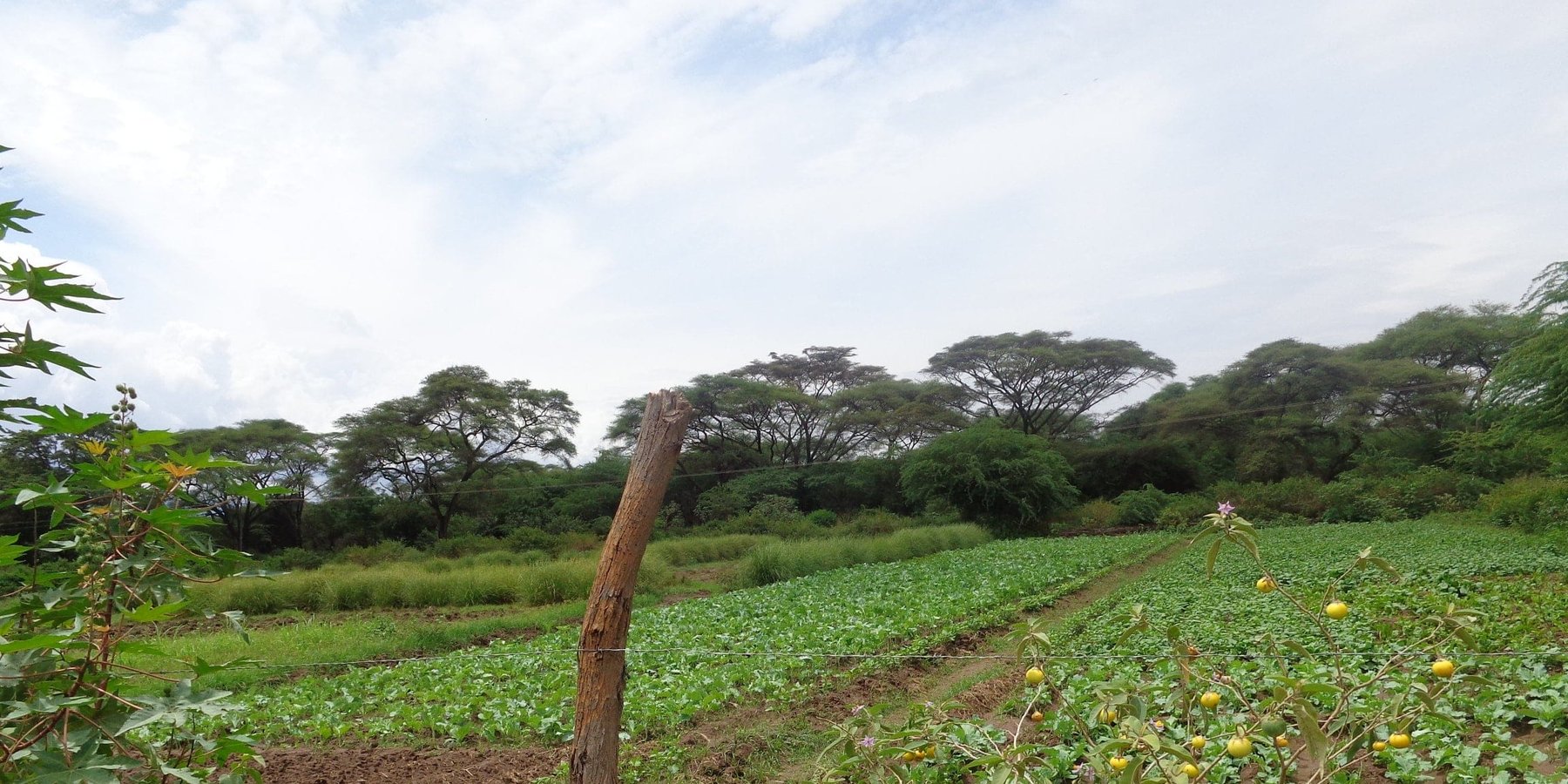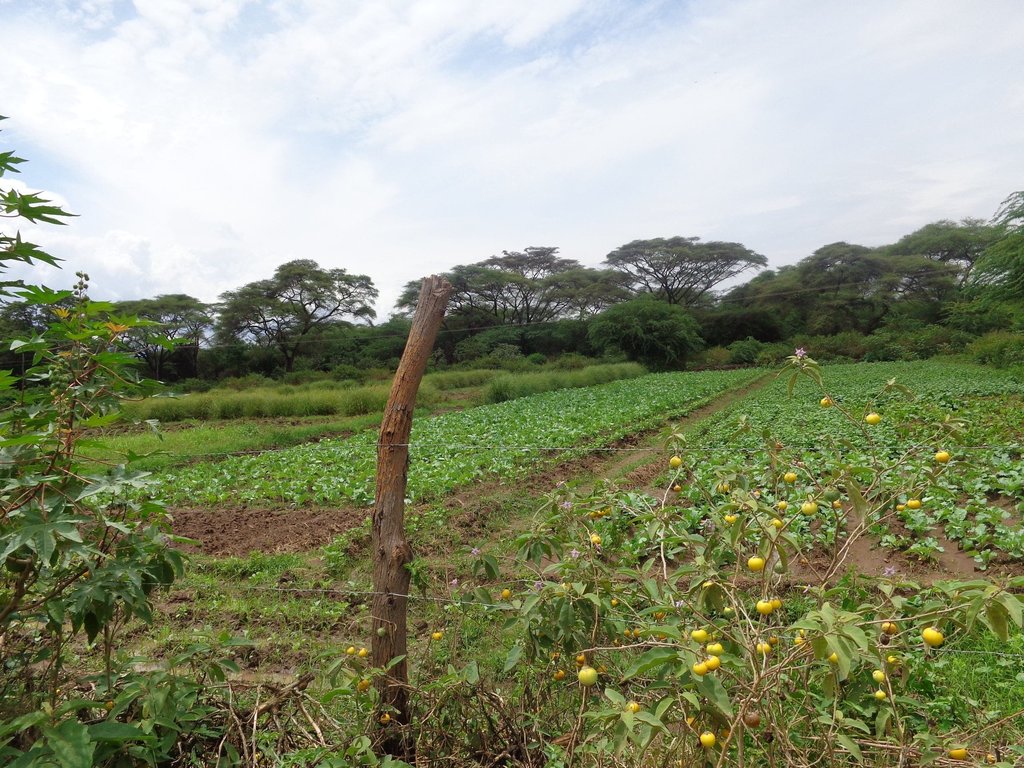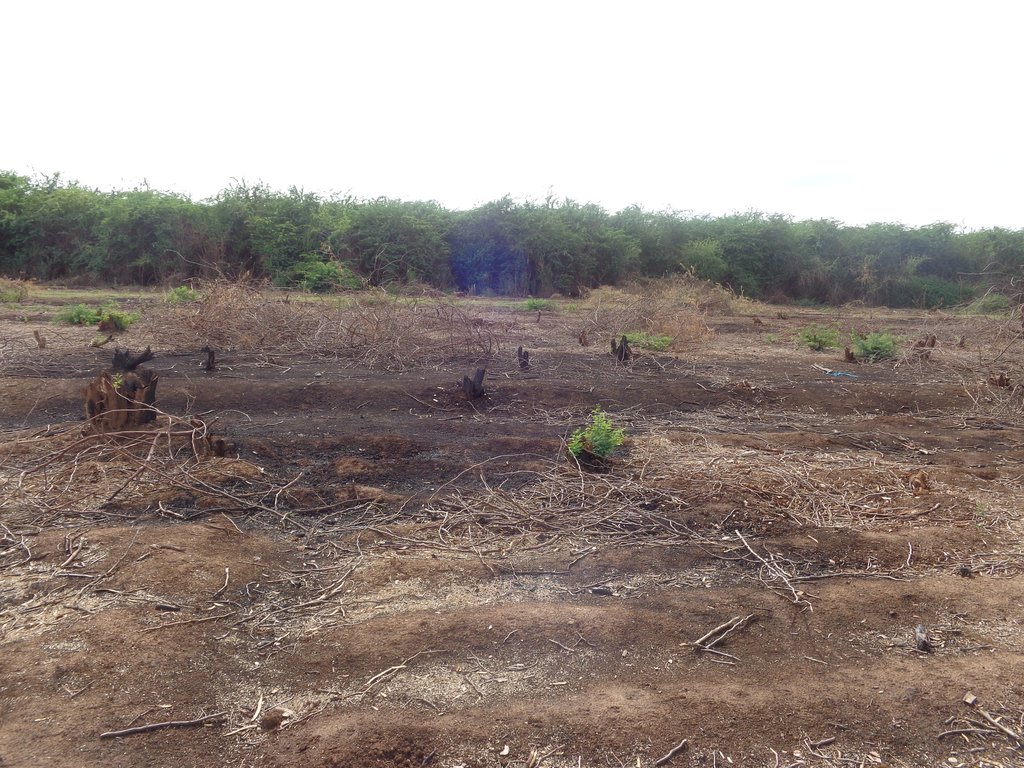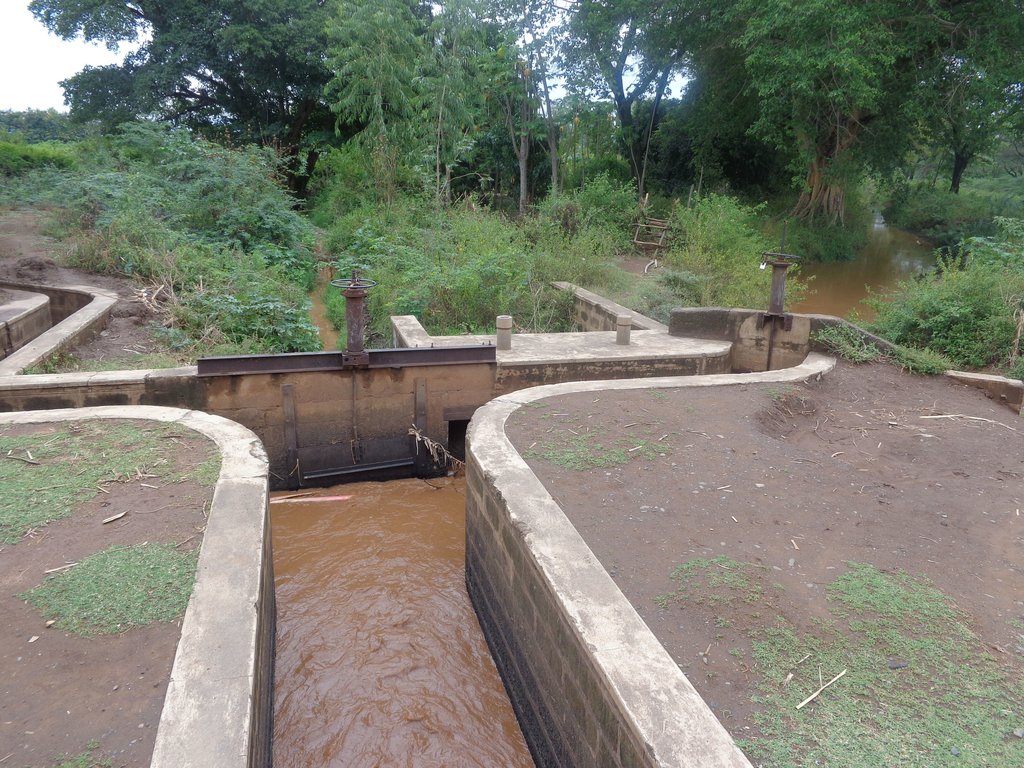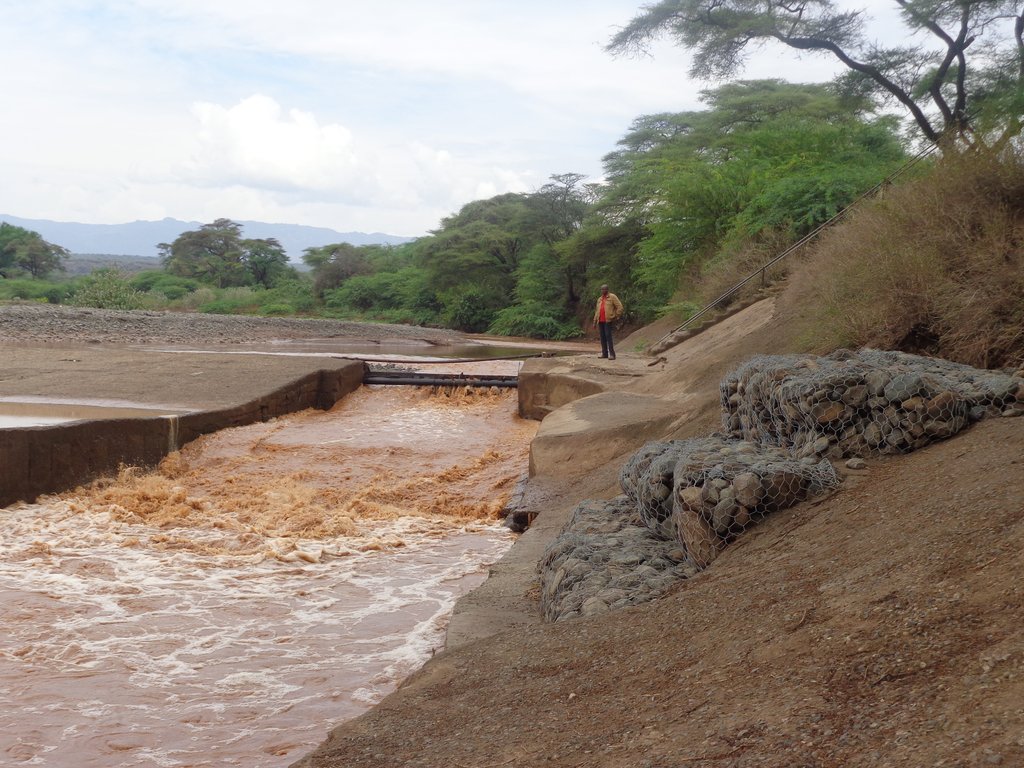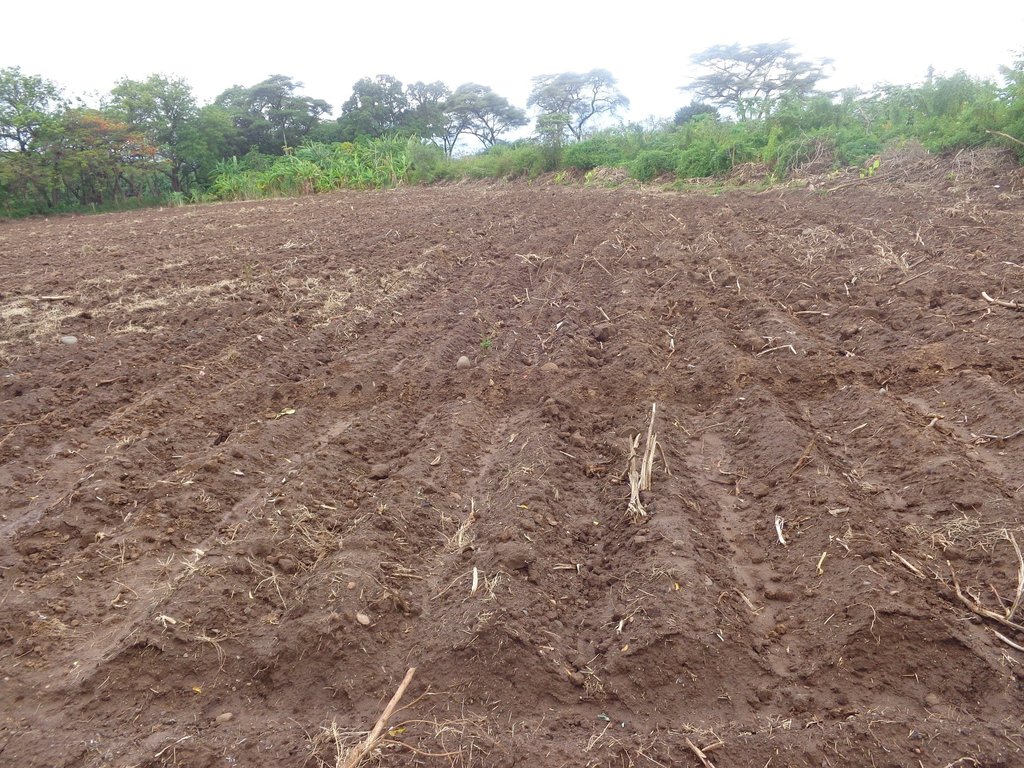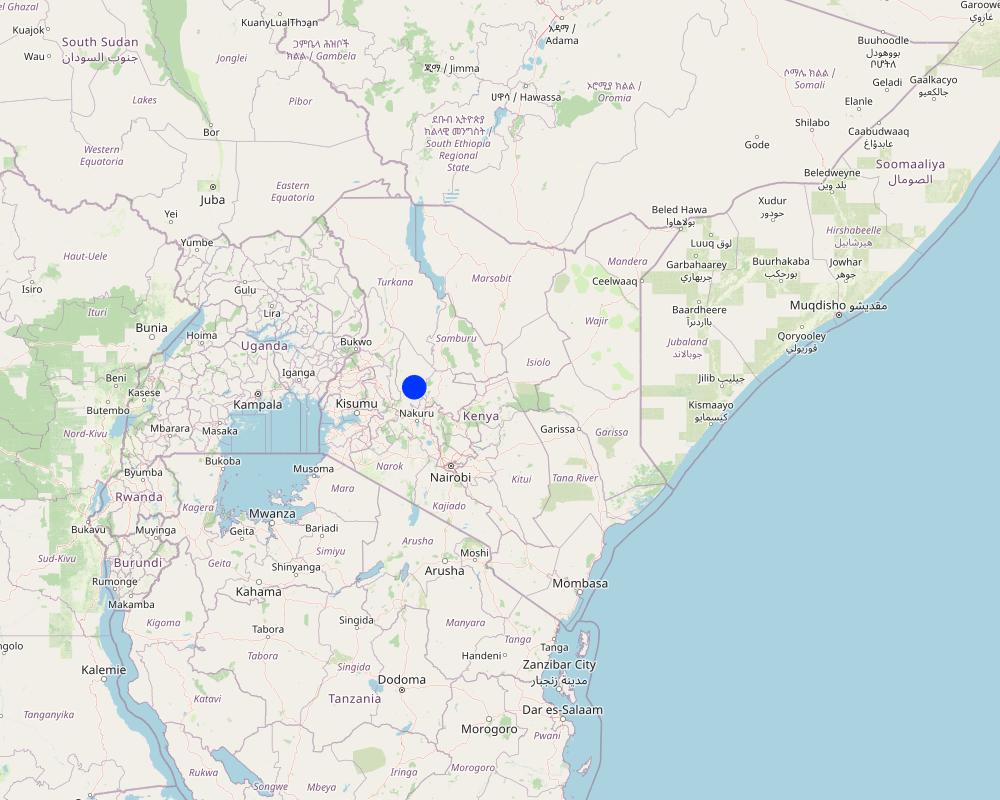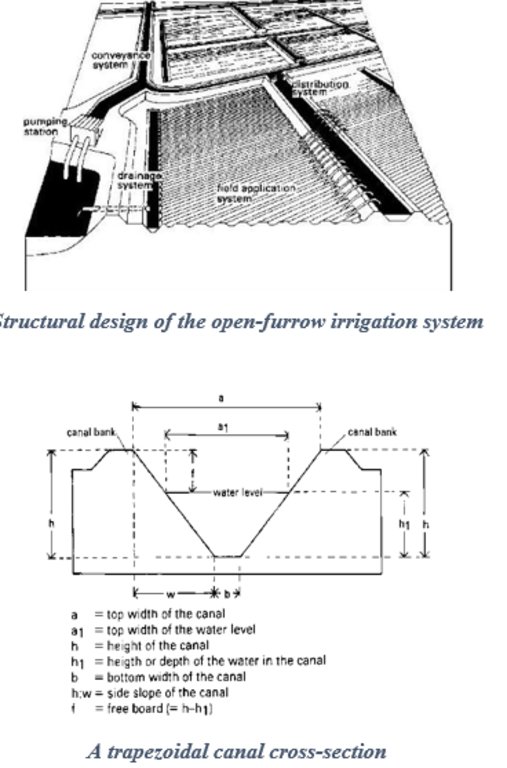Controlling invasive species by physical removal and crop cultivation through open fallow irrigation [เคนยา]
- ผู้สร้างสรรค์:
- การอัพเดท:
- ผู้รวบรวม: Beatrice Otieno
- ผู้เรียบเรียง: Urs Baumgartner, Christian Hergarten
- ผู้ตรวจสอบ: Rima Mekdaschi Studer, Rene Eschen
Cut, Burn, Uproot and Cultivate
technologies_3444 - เคนยา
ดูส่วนย่อย
ขยายทั้งหมด ย่อทั้งหมด1. ข้อมูลทั่วไป
1.2 รายละเอียดที่ติดต่อได้ของผู้รวบรวมและองค์กรที่เกี่ยวข้องในการประเมินและการจัดเตรียมทำเอกสารของเทคโนโลยี
1.3 เงื่อนไขการใช้ข้อมูลที่ได้บันทึกผ่านทาง WOCAT
วันที่เก็บรวบรวมข้อมูล(ภาคสนาม) :
14/03/2018
ผู้รวบรวมและวิทยากรหลักยอมรับเงื่อนไขเกี่ยวกับการใช้ข้อมูลที่ถูกบันทึกผ่านทาง WOCAT:
ใช่
1.4 การเปิดเผยเรื่องความยั่งยืนของเทคโนโลยีที่ได้อธิบายไว้
เทคโนโลยีที่ได้อธิบายไว้นี้เป็นปัญหาของความเสื่อมโทรมโทรมของที่ดินหรือไม่ จึงไม่ได้รับการยอมรับว่าเป็นเทคโนโลยีเพื่อการจัดการที่ดินอย่างยั่งยืน:
ไม่ใช่
แสดงความคิดเห็น:
Cultivation through irrigation in Perkerra scheme begun in 1954, three decades before the introduction of Prosopis in Baringo. Despite the rapid and widespread expansion of the invasive species, it is evident that cultivated areas under the scheme are free from Prosopis, unlike their surrounding neighborhoods which are heavily invaded and rendered unproductive. This is an indication of its sustainability to control Prosopis spread to irrigated land.
2. การอธิบายลักษณะของเทคโนโลยี SLM
2.1 การอธิบายแบบสั้น ๆ ของเทคโนโลยี
คำจำกัดความของเทคโนโลยี:
This is an open-furrow system consisting barriers constructed along a water source such as a river to direct water through a conveyance system by gravity into feeder channels to cultivated land. It is a simple method entailing control of water flow rate and direction to improve water utilization efficiency and enhance productivity of land.
2.2 การอธิบายแบบละเอียดของเทคโนโลยี
คำอธิบาย:
Perkerra irrigation scheme was constructed by the colonial government in 1945 to ensure efficient water utilization, enhance soil productivity and food security. It is an open-furrow system consisting barriers constructed along a water source such as a river to direct water through a conveyance system by gravity into feeder channels to cultivated land. Water control system is constructed between the conveyance and the feeder channels to control the direction and speed of the water.
This technology is suitable on fairly flat, irrigable land with reliable water sources for irrigation. Consideration of population structure is crucial in ascertaining the availability labor force in farmlands. Depending on the size and market orientation of the production system, a stable market is also an important consideration.
Irrigated farming in the scheme is carried out in 3 seasons a year due to availability of reliable water from the permanent Perkerra River. This also ensures that land is never left idle for re-invasion of Prosopis. Activities commence with land clearance conducted at the beginning of every planting season. Prosopis on invaded farmlands are manually cut, burnt and uprooted to minimize chances of the invasive tree from coppicing. The uprooted trunk is utilized in charcoal production for commercial purposes while the small branches are used as firewood for domestic cooking.
The cleared land is then ploughed using a tractor to break the soil structure and provide a fine tilth for planting. This is followed by mechanized ridging to create channels and buffer furrows to convey and retain water long enough to be infiltrated into the soil. Seeds are then sown, a joint activity carried out through farmers’ cooperation. The scheme was originally specialized for bulb onions plantation but has transformed into more diversified food crops for subsistence and commercial purposes. Crops under contractual farming are seed maize, rice, sunflower, green grams, pepper and cow peas while surplus crops under irrigation include tomatoes, vegetables, water melons, subsistence maize crops and commercial fruit trees. In addition, availability of assured market and payment has made the scheme popular for seed maize cultivation. Ongoing experimental research on a variety sweet potatoes to reduce overdependence on maize crops have also shown promising results and are likely to be recommended for implementation. During planting seasons, fallow periods are replaced by rotational cropping and crop diversification. This improves soil structure by alternating deep and shallow-rooted crops. Replacement of the crop during rotation disrupts the life cycle of disease causing organisms, thus controlling pests and diseases as well as improving crop productivity. Consequently, there is minimal application of chemical pesticides, hence reduced chances of pollution.
The irrigated cultivation has improved the welfare of the community by diversifying their sources of livelihood from pastoralism, enhancing food security, eradication of poverty and improving infrastructure such as access roads to the farms. It is a major source of income, directly supporting 1,625 farm households earning an approximate total net income of Ksh. 148, 192,259 Million (Perkerra scheme brief prepared by the National Irrigation board, 2017). Each household is assigned between 0.5 to 4 acres of land. This range might however be narrowed in the near future due to the increasing population in demand for the fixed land resource. The other option under consideration is to reclaim more invaded land and expand the scheme. The challenge facing this approach and is yet to be addressed is limited water resources to sustain the expansion. Lack of suitable market for non-contractual crops as well as poor pricing due to monopolization by contracting institutions is also a great setback to this technology. A good example is the abandonment of pawpaw production by farmers due to marketing problems.
2.3 รูปภาพของเทคโนโลยี
2.5 ประเทศภูมิภาค หรือสถานที่ตั้งที่เทคโนโลยีได้นำไปใช้และได้รับการครอบคลุมโดยการประเมินนี้
ประเทศ:
เคนยา
ภูมิภาค/รัฐ/จังหวัด:
Baringo County
ข้อมูลจำเพาะเพิ่มเติมของสถานที่ตั้ง :
Marigat sub-couty
Map
×2.6 วันที่การดำเนินการ
ถ้าไม่รู้ปีที่แน่นอน ให้ระบุวันที่โดยประมาณ:
- มากกว่า 50 ปี (แบบดั้งเดิม)
2.7 คำแนะนำของเทคโนโลยี
ให้ระบุว่าเทคโนโลยีถูกแนะนำเข้ามาอย่างไร:
- ทางโครงการหรือจากภายนอก
ความคิดเห็น (ประเภทของโครงการ เป็นต้น) :
The scheme was established during the colonial period through local detainees in Marigat. This followed a feasibility study pointing to the suitability of the IIchamus plain for agricultute,
3. การจัดประเภทของเทคโนโลยี SLM
3.1 วัตถุประสงค์หลักของเทคโนโลยี
- ปรับปรุงการผลิตให้ดีขึ้น
- ป้องกันพื้นที่ลุ่มน้ำ/บริเวณท้ายน้ำ โดยร่วมกับเทคโนโลยีอื่นๆ
- สร้างผลกระทบทางด้านเศรษฐกิจที่เป็นประโยชน์
- สร้างผลกระทบทางด้านสังคมที่เป็นประโยชน์
3.2 ประเภทของการใช้ที่ดินในปัจจุบันที่ได้นำเทคโนโลยีไปใช้
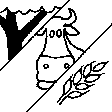
การใช้ที่ดินแบบผสมผสาน (รวมถึงวนเกษตร)
- วนเกษตร (Agroforestry)
ผลิตภัณฑ์หลักหรือบริการ:
Contracted crops: Seed maize, green grams, sunflower
Surplus crops: tomatoes, vegetables, assorted fruit and tree seedlings, pepper
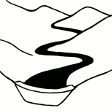
ทางน้ำ แหล่งน้ำ พื้นที่ชุ่มน้ำ
- ทางระบายน้ำ ทางน้ำ
ถ้าการใช้ที่ดินมีการเปลี่ยนแปลงเนื่องมาจากการนำเทคโนโลยีไปปฏิบัติใช้ ให้ระบุการใช้ที่ดินก่อนนำเทคโนโลยีไปปฏิบัติใช้:
IIchamus plain was initially a pastoral land for grazing. Being a state owned land with no one held responsible for its management, the land was poorly managed by the society.
3.3 ข้อมูลเพิ่มเติมเกี่ยวกับการใช้ที่ดิน
การใช้น้ำของที่ดินที่มีการใช้เทคโนโลยีอยู่:
- น้ำฝนร่วมกับการชลประทาน
แสดงความคิดเห็น:
Channeling of irrigation water into farms is restricted to dry seasons and temporarily halted during the rainy season.
จำนวนของฤดูเพาะปลูกต่อปี:
- 3
ระบุ:
The irrigation scheme is subjected to continuous cultivation with contracted crops planted in 2 seasons and a surplus crop on a third season in a year. Crop rotation and diversification is practiced to improve soil productivity, control pests, reduce soil erosion and enhance soil structure.
3.4 กลุ่ม SLM ที่ตรงกับเทคโนโลยีนี้
- ระบบหมุนเวียน (การปลูกพืชหมุนเวียน การพักดิน การเกษตรแบบไร่เลื่อนลอย)
- การจัดการด้านชลประทาน (รวมถึงการลำเลียงส่งน้ำ การระบายน้ำ)
- การผันน้ำและการระบายน้ำ
3.5 กระจายตัวของเทคโนโลยี
ระบุการกระจายตัวของเทคโนโลยี:
- กระจายไปอย่างสม่ำเสมอในพื้นที่
ถ้าหากว่าเทคโนโลยีได้มีการกระจายออกไปอย่างสม่ำเสมอในพื้นที่ ให้ระบุปริมาณพื้นที่ที่ได้รับการครอบคลุมถึง:
- > 10,000 ตร.กม.
แสดงความคิดเห็น:
The technology are specifically applied along the irrigation scheme with sufficient water for irrigation
3.6 มาตรการ SLM ที่ประกอบกันเป็นเทคโนโลยี

มาตรการจัดการพืช
- A1: พืช/สิ่งปกคลุมดิน
- A2: อินทรียวัตถุในดิน/ความอุดมสมบูรณ์ในดิน
- A5: การจัดการเมล็ดพันธุ์ การปรับปรุงพันธุ์

มาตรการอนุรักษ์ด้วยวิธีพืช
- V3: กำจัดพืชออกให้หมด
- V4: การแทนที่หรือการนำพันธุ์ต่างถิ่น/ที่รุกล้ำเข้ามา ออกไปจากพื้นที่

มาตรการอนุรักษ์ด้วยโครงสร้าง
- S2: ทำนบ เขื่อนดิน
- S5: เขื่อน ชั้นดินที่แน่นแข็งบ่อน้ำ
- S7: การกักเก็บน้ำ/การส่งลำเลียง/อุปกรณ์การชลประทาน

มาตรการอนุรักษ์ด้วยการจัดการ
- M1: การเปลี่ยนรูปแบบของการใช้ประโยชน์ที่ดิน
- M4: การเปลี่ยนแปลงช่วงเวลาให้เหมาะแก่การทำกิจกรรม
- M5: การควบคุมหรือการเปลี่ยนแปลงขององค์ประกอบของชนิดพันธุ์
3.7 รูปแบบหลักของการเสื่อมโทรมของที่ดินที่ได้รับการแก้ไขโดยเทคโนโลยี

การกัดกร่อนของดินโดยน้ำ
- Wt (Loss of topsoil): การสูญเสียดินชั้นบนหรือการกัดกร่อนที่ผิวดิน
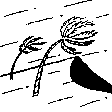
การกัดกร่อนของดินโดยลม
- Et (Loss of topsoil): การสูญเสียดินชั้นบน

การเสื่อมโทรมของดินทางด้านเคมี
- Cn (Fertility decline): ความอุดมสมบูรณ์และปริมาณอินทรียวัตถุในดินถูกทำให้ลดลงไป (ไม่ได้เกิดจากสาเหตุการกัดกร่อน)
- Cs (Salinization/alkalinization): การสะสมเกลือหรือการทำให้เป็นด่าง

การเสื่อมโทรมของดินทางด้านชีวภาพ
- Bh (Loss of habitat): การสูญเสียแหล่งที่อยู่
- Bq (Quantity/biomass decline): การลดลงของปริมาณหรือมวลชีวภาพ
- Bs (Quality and species composition): องค์ประกอบหรือความหลากหลายทางคุณภาพและชนิดพันธุ์ลดลง
- Bp (Increase of pests/diseases): การเพิ่มขึ้นของศัตรูพืชและโรคพืช

การเสื่อมโทรมของน้ำ
- Ha (Aridification): การเกิดความแห้งแล้ง
3.8 การป้องกัน การลดลง หรือการฟื้นฟูความเสื่อมโทรมของที่ดิน
ระบุเป้าหมายของเทคโนโลยีกับความเสื่อมโทรมของที่ดิน:
- ฟื้นฟูบำบัดที่ดินที่เสื่อมโทรมลงอย่างมาก
4. ข้อมูลจำเพาะด้านเทคนิค กิจกรรมการนำไปปฏิบัติใช้ ปัจจัยนำเข้า และค่าใช้จ่าย
4.1 แบบแปลนทางเทคนิคของเทคโนโลยี
4.2 ข้อมูลจำเพาะด้านเทคนิคและการอธิบายแบบแปลนทางเทคนิค
The intake structure convey water from the main water source to the irrigation system. It may consist of a water pump or a barrier designed for this purpose. The water is directed to a conveyance system of open canals which control the flow and direction of water to different field application and distribution systems. The canals depth (h) is preferred to exceed the expected maximum water level (h){h>h1} of water within the irrigation system to minimize bank overflow. The side slope is a ratio of the vertical height to the horizontal canal width (h:w). They are fitted with water measurement, erosion and distribution control structures to regulate accurate distribution of water to the farms with minimum siltation of the banks. The water is then distributed to field ditches which transfer it to the irrigated farm. These are narrow waterways dug along the farms with checks across their lengths to hold and raise the upstream water levels long enough before releasing it to the next segment of the field ditch. This is meant to increase the rate of water infiltration into the soil.
4.3 ข้อมูลทั่วไปเกี่ยวกับการคำนวณปัจจัยนำเข้าและค่าใช้จ่าย
ให้ระบุว่าค่าใช้จ่ายและปัจจัยนำเข้าได้รับการคำนวณอย่างไร:
- ต่อหน่วยเทคโนโลยี
โปรดระบุหน่วย:
hactares
ระบุปริมาตร ความยาว เป็นต้น (ถ้าเกี่ยวข้อง):
1
อื่นๆ หรือสกุลเงินประจำชาติ (ระบุ):
KES
ระบุอัตราแลกเปลี่ยนจากดอลลาร์สหรัฐเป็นสกุลเงินท้องถิ่น (ถ้าเกี่ยวข้อง) คือ 1 เหรียญสหรัฐ =:
100.0
ระบุค่าเฉลี่ยของค่าจ้างในการจ้างแรงงานต่อวัน:
500
4.4 กิจกรรมเพื่อการจัดตั้ง
| กิจกรรม | ประเภทของมาตรการ | ช่วงเวลาดำเนินการ | |
|---|---|---|---|
| 1. | Construct gravity intake system | ด้วยโครงสร้าง | Once during establishment |
| 2. | Excavation of water canals | ด้วยโครงสร้าง | Once during establishment |
| 3. | Establishment of water control structures | ด้วยโครงสร้าง | Once during establishment |
| 4. | Land preparation ( Clearance and partitioning) | ด้วยโครงสร้าง | Once during establishment |
| 5. | Construction of a suitable road network | ด้วยโครงสร้าง | Once during establishment |
แสดงความคิดเห็น:
Activities involved are the construction of a gravity intake system, excavation of water canals, construction of a suitable road network and water control structures. Prior considerations are reliable water source, availability of irrigable land and labor for cultivation.
4.5 ค่าใช้จ่ายของปัจจัยนำเข้าที่จำเป็นสำหรับการจัดตั้ง
ถ้าเป็นไปได้ให้แจกแจงรายละเอียดต้นทุนการบำรุงรักษาตามตารางข้างล่างดังต่อไปนี้ ให้ระบุลงไปถึงปัจจัยนำเข้าและค่าใช้จ่ายต่อปัจจัยนำเข้า ถ้าไม่สามารถแจกแจงรายละเอียดต้นทุนได้ ให้ทำการประมาณค่าใช้จ่ายทั้งหมดในการบำรุงรักษาเทคโนโลยี:
600000000.0
แสดงความคิดเห็น:
The initial establishment and construction of the irrigation infrastructure is often conducted by the national government due to associated high costs approximated by key informants to be Ksh, 600, 000,000 (600,000 USD). This is however an initial, one off expenditure that are non-recurrent.
4.6 การบำรุงรักษาสภาพหรือกิจกรรมที่เกิดขึ้นเป็นประจำ
| กิจกรรม | ประเภทของมาตรการ | ช่วงระยะเวลา/ความถี่ | |
|---|---|---|---|
| 1. | Clearing land | จัดการพืช | 3 times a year before every planting season. |
| 2. | Ploughing | จัดการพืช | 3 times a year before every planting season. |
| 3. | Ridging/Cutting furrows | ด้วยโครงสร้าง | 3 times a year before every planting season. |
| 4. | De-silting of canals | ด้วยการจัดการ | 3 times a year before every planting season. |
| 5. | Planting | จัดการพืช | 3 times a year. |
| 6. | first irrigation | ด้วยโครงสร้าง | 3 times a year after planting (3 to 5 days per season) |
| 7. | Pest control | จัดการพืช | Whenever applicable |
| 8. | Weeding | จัดการพืช | Once every season |
| 9. | Second irrigation | ด้วยโครงสร้าง | 10 to 12 (each time withinn 3 to 4 days) per planting season. |
| 10. | Top dressing ( Apply fertilizer) | จัดการพืช | Once every season |
| 11. | Harvesting | จัดการพืช | Once every season |
| 12. | Shelling | จัดการพืช | Once every season |
แสดงความคิดเห็น:
Maintenance activities mentioned above are dependent on the status of an individual's farm, availability of resources and the purpose for cultivation. Farm produce cultivated under contracted terms will however need to follow strict procedures for them to meet the minimum requirements.
4.7 ค่าใช้จ่ายของปัจจัยนำเข้าและกิจกรรมที่เกิดขึ้นเป็นประจำที่ต้องการการบำรุงรักษา (ต่อปี)
| ปัจจัยนำเข้า | หน่วย | ปริมาณ | ค่าใช้จ่ายต่อหน่วย | ค่าใช้จ่ายทั้งหมดต่อปัจจัยนำเข้า | %ของค่าใช้จ่ายที่ก่อให้เกิดขึ้นโดยผู้ใช้ที่ดิน | |
|---|---|---|---|---|---|---|
| แรงงาน | Land clearance | Man-hour | 540.0 | 120.0 | 64800.0 | 100.0 |
| แรงงาน | Partitioning | Man-hour | 180.0 | 100.0 | 18000.0 | 100.0 |
| แรงงาน | Planting | Man-hour | 90.0 | 100.0 | 9000.0 | 100.0 |
| อุปกรณ์ | Ploughing tractor | Hours | 18.0 | 420.0 | 7560.0 | 100.0 |
| อุปกรณ์ | Ridging tractor | Hours | 18.0 | 420.0 | 7560.0 | 100.0 |
| วัสดุด้านพืช | Seeds and seedlings | Kg | 75.0 | 150.0 | 11250.0 | 100.0 |
| วัสดุด้านพืช | Channeling water for irrigation | Season | 3.0 | 2000.0 | 6000.0 | 100.0 |
| ปุ๋ยและสารฆ่า/ยับยั้งการเจริญเติบโตของสิ่งมีชีวิต (ไบโอไซด์) | Fertilizer | Kg | 150.0 | 50.0 | 7500.0 | 100.0 |
| ค่าใช้จ่ายทั้งหมดของการบำรุงรักษาสภาพเทคโนโลยี | 131670.0 | |||||
4.8 ปัจจัยสำคัญที่สุดที่มีผลกระทบต่อค่าใช้จ่าย
ปัจจัยสำคัญที่สุดที่มีผลกระทบต่อค่าใช้จ่ายต่างๆ:
Size of land
Disease and pest outbreak
Crop variety as contracted crops minimum requirements which may be costly to meet
Occurrence of rainy seasons especially during harvesting which affect the drying cost and output of produce. Seed maize, for example, may not meet the required moisture content when aired during the rainy season hence lowering the net income from them.
Condition of the farm e.g invasion level by Prosopis
5. สิ่งแวดล้อมทางธรรมชาติและของมนุษย์
5.1 ภูมิอากาศ
ฝนประจำปี
- < 250 ม.ม.
- 251-500 ม.ม.
- 501-750 ม.ม.
- 751-1,000 ม.ม.
- 1,001-1,500 ม.ม.
- 1,501-2,000 ม.ม.
- 2,001-3,000 ม.ม.
- 3,001-4,000 ม.ม.
- > 4,000 ม.ม.
ระบุปริมาณน้ำฝนเฉลี่ยรายปี (ถ้ารู้) :หน่วย ม.ม.
671.00
ข้อมูลจำเพาะ/ความคิดเห็นเรื่องปริมาณน้ำฝน:
Rainfall is characterized by seasonal and annual fluctuations
เขตภูมิอากาศเกษตร
- กึ่งแห้งแล้ง
The area is in a semi-arid zone with temperatures ranging between 16 to 36 degrees, averagely 24.6 degrees, accompanied by high evaporation rates of up to 6mm. It experiences an average rainfall of 671 mm annually which are very erratic.
5.2 สภาพภูมิประเทศ
ค่าเฉลี่ยความลาดชัน:
- ราบเรียบ (0-2%)
- ลาดที่ไม่ชัน (3-5%)
- ปานกลาง (6-10%)
- เป็นลูกคลื่น (11-15%)
- เป็นเนิน (16-30%)
- ชัน (31-60%)
- ชันมาก (>60%)
ธรณีสัณฐาน:
- ที่ราบสูง/ที่ราบ
- สันเขา
- ไหล่เขา
- ไหล่เนินเขา
- ตีนเนิน
- หุบเขา
ระดับความสูง:
- 0-100 เมตร
- 101-500 เมตร
- 501-1,000 เมตร
- 1,001-1,500 เมตร
- 1,501-2,000 เมตร
- 2,001-2,500 เมตร
- 2,501-3,000 เมตร
- 3,001-4,000 เมตร
- > 4,000 เมตร
ให้ระบุถ้าเทคโนโลยีได้ถูกนำไปใช้:
- ไม่เกี่ยวข้อง
ความคิดเห็นและข้อมูลจำเพาะเพิ่มเติมเรื่องสภาพภูมิประเทศ:
The technology is applied in relatively flat land to increase water retention long enough to be infiltrated into the soil
5.3 ดิน
ค่าเฉลี่ยความลึกของดิน:
- ตื้นมาก (0-20 ซ.ม.)
- ตื้น (21-50 ซ.ม.)
- ลึกปานกลาง (51-80 ซ.ม.)
- ลึก (81-120 ซ.ม.)
- ลึกมาก (>120 ซ.ม.)
เนื้อดิน (ดินชั้นบน):
- ละเอียด/หนัก (ดินเหนียว)
เนื้อดินล่าง (> 20 ซ.ม.ต่ำจากผิวดิน):
- ละเอียด/หนัก (ดินเหนียว)
อินทรียวัตถุในดิน:
- ต่ำ (<1%)
(ถ้ามี) ให้แนบคำอธิบายเรื่องดินแบบเต็มหรือระบุข้อมูลที่มีอยู่ เช่น ชนิดของดิน ค่า pH ของดินหรือความเป็นกรดของดิน ความสามารถในการแลกเปลี่ยนประจุบวก ไนโตรเจน ความเค็ม เป็นต้น:
Clay soil with alkaline pH of 7.5 , rich in calcium phosphate but low in organic matter
5.4 ความเป็นประโยชน์และคุณภาพของน้ำ
น้ำไหลบ่าที่ผิวดิน:
ดี
คุณภาพน้ำ (ที่ยังไม่ได้บำบัด):
เป็นน้ำใช้เพื่อการเกษตรเท่านั้น (การชลประทาน)
ความเค็มของน้ำเป็นปัญหาหรือไม่:
ใช่
กำลังเกิดน้ำท่วมในพื้นที่หรือไม่:
ใช่
5.5 ความหลากหลายทางชีวภาพ
ความหลากหลายทางชนิดพันธุ์:
- ต่ำ
ความหลากหลายของแหล่งที่อยู่:
- ต่ำ
ความคิดเห็นและข้อมูลจำเพาะเพิ่มเติมของความหลากหลายทางชีวภาพ:
Prosopis has heavily invaded the land, encroaching agro-pastoral land and outcompeting native species leading to degradation of native species and habitats.
5.6 ลักษณะของผู้ใช้ที่ดินที่นำเทคโนโลยีไปปฏิบัติใช้
อยู่กับที่หรือเร่ร่อน:
- อยู่กับที่
แนวทางการตลาดของระบบการผลิต:
- ผสม (การเลี้ยงชีพ/ทำการค้า)
รายได้ที่มาจากนอกฟาร์ม:
- 10-50% ของรายได้ทั้งหมด
ระดับของความมั่งคั่งโดยเปรียบเทียบ:
- จน
เป็นรายบุคคล/ครัวเรือน:
- เป็นรายบุคคล/ครัวเรือน
ระดับของการใช้เครื่องจักรกล:
- งานที่ใช้แรงกาย
- การใช้เครื่องจักรหรือเครื่องยนต์
เพศ:
- หญิง
- ชาย
อายุของผู้ใช้ที่ดิน:
- วัยกลางคน
- ผู้สูงอายุ
5.7 พื้นที่เฉลี่ยของที่ดินที่เป็นเจ้าของหรือเช่าโดยผู้ใช้ที่ดินที่นำเทคโนโลยีไปปฏิบัติใช้
- < 0.5 เฮกตาร์
- 0.5-1 เฮกตาร์
- 1-2 เฮกตาร์
- 2-5 เฮกตาร์
- 5-15 เฮกตาร์
- 15-50 เฮกตาร์
- 50-100 เฮกตาร์
- 100-500 เฮกตาร์
- 500-1,000 เฮกตาร์
- 1,000-10,000 เฮกตาร์
- >10,000 เฮกตาร์
พิจารณาว่าเป็นขนาดเล็ก กลาง หรือขนาดใหญ่ (ซึ่งอ้างอิงถึงบริบทระดับท้องถิ่น):
- ขนาดใหญ่
แสดงความคิดเห็น:
Current land allocated by the government for the practice is an estimate of 1,800 ha. Pressure due to population increase has however triggered plans for future expansion.
5.8 กรรมสิทธิ์ในที่ดิน สิทธิในการใช้ที่ดินและสิทธิในการใช้น้ำ
กรรมสิทธิ์ในที่ดิน:
- รัฐ
สิทธิในการใช้ที่ดิน:
- เกี่ยวกับชุมชน (ถูกจัดระเบียบ)
สิทธิในการใช้น้ำ:
- เกี่ยวกับชุมชน (ถูกจัดระเบียบ)
แสดงความคิดเห็น:
The scheme is state owned , leased to the community who nominate a 7 member advisory committee tasked with all land administration aspects ranging from land adjudication, allocation, succession and dispute management as well as set laws guiding water utilization and conservation.
5.9 การเข้าถึงบริการและโครงสร้างพื้นฐาน
สุขภาพ:
- จน
- ปานกลาง
- ดี
การศึกษา:
- จน
- ปานกลาง
- ดี
ความช่วยเหลือทางด้านเทคนิค:
- จน
- ปานกลาง
- ดี
การจ้างงาน (เช่น ภายนอกฟาร์ม):
- จน
- ปานกลาง
- ดี
ตลาด:
- จน
- ปานกลาง
- ดี
พลังงาน:
- จน
- ปานกลาง
- ดี
ถนนและการขนส่ง:
- จน
- ปานกลาง
- ดี
น้ำดื่มและการสุขาภิบาล:
- จน
- ปานกลาง
- ดี
บริการด้านการเงิน:
- จน
- ปานกลาง
- ดี
6. ผลกระทบและสรุปคำบอกกล่าว
6.1 ผลกระทบในพื้นที่ดำเนินการ (On-site) จากการใช้เทคโนโลยี
ผลกระทบทางด้านเศรษฐกิจและสังคม
การผลิต
การผลิตพืชผล
พื้นที่สำหรับการผลิต
จำนวนก่อน SLM:
567 ha
หลังจาก SLM:
1,745 ha
แสดงความคิดเห็น/ระบุ:
the area developed for furrow irrigation has increased by 1,178 ha between 1958 when the operations begun to date. This is more than twice the initial land size allocated and utilized for irrigation purposes.
การจัดการที่ดิน
แสดงความคิดเห็น/ระบุ:
Development of the technology has transformed it from an open access to an organized communal tenure system with communally-designed restrictions to its access, utilization and management.
ความเป็นประโยชน์และคุณภาพของน้ำ
คุณภาพน้ำสำหรับปศุสัตว์
แสดงความคิดเห็น/ระบุ:
There are chances of water pollution when contaminated irrigation water flows back to the animal watering points.
ความต้องการน้ำจากการชลประทาน
แสดงความคิดเห็น/ระบุ:
The progressive increase of area under cultivation as well as prolonged dry seasons over the years have culminated into increased water consumption hence a high demand for the same.
รายได้และค่าใช้จ่าย
รายได้จากฟาร์ม
หลังจาก SLM:
Net income of 148 192 259 million Kenya shillings
ความหลากหลายของแหล่งผลิตรายได้
แสดงความคิดเห็น/ระบุ:
Farming activities have diversified and increased income sources to the community who depended mainly on pastoralism. This has been enhanced by a wide variety of crops being cultivated through irrigation.
ภาระงาน
แสดงความคิดเห็น/ระบุ:
Farming activities (tedious cutting, burning and uprooting of Prosopis in invaded farms, ploughing, weeding and harvesting) are all physical activities that increase the workload of the communities involved.
ผลกระทบด้านนิเวศวิทยา
ความหลากหลายทางชีวภาพของพืชและสัตว์
การปกคลุมด้วยพืช
มวลชีวภาพ/เหนือดินชั้น C
ความหลากหลายทางชีวภาพของพืช
พืชพันธุ์ต่างถิ่นที่รุกล้ำเข้ามา
แสดงความคิดเห็น/ระบุ:
Irrigated land has to undergo clearance of all Invasive species, in this case, Prosopis during land preparation activities. This is carried out through a cut-burn-uproot approach to minimize chances of their proliferation. Any re-growing invasive plant is uprooted before maturity to prevent further competition for water and nutrient with cultivated crops. Chances of re-invasion are also minimized as land is never left idle for colonization by Prosopis. This has greatly decreased invasive cover on irrigated land.
ลดความเสี่ยงของภัยพิบัติ
ผลกระทบจากภัยแล้ง
แสดงความคิดเห็น/ระบุ:
Drought related impacts such as malnutrition, famine and death have been reduced by irrigation practices which increases food insecurity independent of the season.
6.2 ผลกระทบนอกพื้นที่ดำเนินการ (Off-site) จากการใช้เทคโนโลยี
น้ำที่ใช้ประโยชน์ได้
แสดงความคิดเห็น/ระบุ:
Diversion of water into open channels for irrigation reduce the downstream flow for offsite usage downstream.
น้ำท่วมพื้นที่ท้ายน้ำ
แสดงความคิดเห็น/ระบุ:
Potential flood water are diverted to farms hence reducing downstream flooding. However, this impact may not be significant during heavy downpours where diversion valves are closed to prevent unnecessary water logging on farmlands.
6.3 การเผชิญและความตอบสนองของเทคโนโลยีต่อการเปลี่ยนแปลงสภาพภูมิอากาศที่ค่อยเป็นค่อยไป และสภาพรุนแรงของภูมิอากาศ / ภัยพิบัติ (ที่รับรู้ได้โดยผู้ใช้ที่ดิน)
การเปลี่ยนแปลงสภาพภูมิอากาศที่ค่อยเป็นค่อยไป
การเปลี่ยนแปลงสภาพภูมิอากาศที่ค่อยเป็นค่อยไป
| ฤดู | ประเภทของการเปลี่ยนแปลงสภาพภูมิอากาศที่ค่อยเป็นค่อยไป และสภาพรุนแรงของภูมิอากาศ | เทคโนโลยีมีวิธีการรับมืออย่างไร | |
|---|---|---|---|
| ฝนตามฤดู | ฤดูฝน | เพิ่มขึ้น | ปานกลาง |
สภาพรุนแรงของภูมิอากาศ (ภัยพิบัติ)
ภัยพิบัติทางชีวภาพ
| เทคโนโลยีมีวิธีการรับมืออย่างไร | |
|---|---|
| โรคระบาด | ไม่ดี |
| การบุกรุกของแมลง / หนอน | ไม่ดี |
6.4 การวิเคราะห์ค่าใช้จ่ายและผลประโยชน์ที่ได้รับ
ผลประโยชน์ที่ได้รับเปรียบเทียบกับค่าใช้จ่ายในการจัดตั้งเป็นอย่างไร (จากมุมมองของผู้ใช้ที่ดิน)
ผลตอบแทนระยะสั้น:
ด้านบวกเล็กน้อย
ผลตอบแทนระยะยาว:
ด้านบวก
ผลประโยชน์ที่ได้รับเปรียบเทียบกับค่าใช้จ่ายในการบำรุงรักษาหรือต้นทุนที่เกิดขึ้นซ้ำอีก เป็นอย่างไร (จากมุมมองของผู้ใช้ที่ดิน)
ผลตอบแทนระยะสั้น:
ด้านบวกเล็กน้อย
ผลตอบแทนระยะยาว:
ด้านบวก
6.5 การปรับตัวของเทคโนโลยี
- 1-10%
ถ้ามีข้อมูลให้บอกปริมาณด้วย (จำนวนของครัวเรือนหรือครอบคลุมพื้นที่):
Direct beneficiaries of the technologies are about 13,000 people. However, indirect beneficiaries from the transportation and sale of the produce may double this number
จากทั้งหมดที่ได้รับเทคโนโลยีเข้ามามีจำนวนเท่าใดที่ทำแบบทันที โดยไม่ได้รับการจูงใจด้านวัสดุหรือการเงินใด ๆ:
- 90-100%
แสดงความคิดเห็น:
All operation are carried out at the full expense of the land users. Credits advanced to them have to be repaid with at least 11% interest
6.6 การปรับตัว
เทคโนโลยีได้รับการปรับเปลี่ยนเมื่อเร็วๆนี้ เพื่อให้ปรับตัวเข้ากับสภาพที่กำลังเปลี่ยนแปลงหรือไม่:
ใช่
ถ้าตอบว่าใช่ ให้ระบุว่าเงื่อนไขการเปลี่ยนแปลงใดที่ถูกปรับตัว:
- การเปลี่ยนแปลงแบบค่อยเป็นค่อยไปและสภาพรุนแรงของภูมิอากาศ
ให้ระบุการปรับตัวของเทคโนโลยี (การออกแบบ วัสดุหรือชนิดพันธุ์ เป็นต้น):
Water conveyance along the furrows to the farms is halted during heavy downpour to minimize water logging.
6.7 จุดแข็ง / ข้อได้เปรียบ / โอกาสของเทคโนโลยี
| จุดแข็ง / ข้อได้เปรียบ / โอกาสในทัศนคติของผู้ใช้ที่ดิน |
|---|
| A source of finance to land users through sale of their produce. |
| จุดแข็ง / ข้อได้เปรียบ / โอกาสในทัศนคติของผู้รวบรวมหรือวิทยากรหลัก |
|---|
| Continuous farming activities have ensured that land is constantly managed, limiting the proliferation of Prosopis weeds which have adverse impacts to the ecosystem and livelihoods. |
| Improved human welfare by enhancing their financial stability. An extension of this is indirect benefit through employment creation to farm laborers, merchants and buyers of the fresh and healthy farm produce. |
| Increased food security |
6.8 จุดอ่อน / ข้อเสียเปรียบ / ความเสี่ยงของเทคโนโลยีและวิธีการแก้ไข
| จุดอ่อน / ข้อเสียเปรียบ / ความเสี่ยงในทัศนคติของผู้ใช้ที่ดิน | มีวิธีการแก้ไขได้อย่างไร |
|---|---|
| Poor market prices for their produce. | They feel they have no option due to inadequate knowledge and access to other available markets |
| Pests and disease out break such as the fall armyworm. | Advisory services are offered by research institutions to stakeholders on how to manage and control pests. |
| จุดอ่อน / ข้อเสียเปรียบ / ความเสี่ยงในทัศนคติของผู้รวบรวมหรือวิทยากรหลัก | มีวิธีการแก้ไขได้อย่างไร |
|---|---|
| Monopoly of the market by the contracting institutions may lead to poor pricing or tight minimum requirements such as the quality of output leading to losses. | Diversification of market to tighten competition that may offer better prices to farmers. |
| High chances of water pollution by chemicals and fertilizers that may be washed away by the running water | Minimize application of chemicals as possible accompanied by integrated nutrient management practices. |
| Post harvest losses when supply exceeds demand | Proper timing of planting season whereby harvesting coincides with seasons of shortage and scarcity to maximize returns. |
7. การอ้างอิงและการเชื่อมต่อ
7.1 วิธีการและแหล่งข้อมูล
- ไปเยี่ยมชมภาคสนาม การสำรวจพื้นที่ภาคสนาม
2
- การสัมภาษณ์กับผู้ใช้ที่ดิน
2
- การสัมภาษณ์ผู้เชี่ยวชาญด้าน SLM หรือผู้ชำนาญ
3
- การเก็บรวบรวมมาจากรายงานและเอกสารที่มีอยู่
2
7.2 การอ้างอิงถึงสิ่งตีพิมพ์
หัวข้อ, ผู้เขียน, ปี, หมายเลข ISBN:
Brouwer, C., Goffeau, A., and Heibloem, M. (1985): Irrigation Water Management: Training Manual No. 1
ชื่อเรื่อง ผู้เขียน ปี ISBN:
http://www.fao.org/docrep/r4082e/r4082e00.htm#Contents
7.3 เชื่อมโยงกับข้อมูลที่มีอยู่บนออนไลน์
ชื่อเรื่องหรือคำอธิบาย:
Perkerra Irrigation scheme Brief
URL:
https://www.nib.or.ke/projects/public-irrigation-schemes/perkerra-irrigation-scheme
ชื่อเรื่องหรือคำอธิบาย:
The 9 Benefits of Crop Rotation to the Environment
URL:
http://richmondvale.org/crop-rotation/
ลิงก์และโมดูล
ขยายทั้งหมด ย่อทั้งหมดลิงก์
ไม่มีลิงก์
โมดูล
ไม่มีโมดูล


